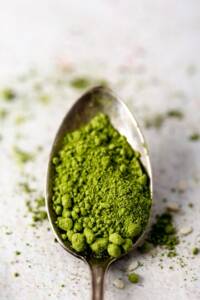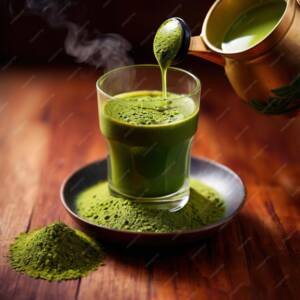
In recent years, matcha has become one of the most popular drinks in the world of health and nutrition. This traditional Japanese drink is known for its many health benefits, making it a preferred choice for many people looking to improve their healthy lifestyle. With the increasing interest in natural drinks rich in antioxidants, the matcha industry has witnessed remarkable development in both local and global markets.
In this article, we will review everything related to the matcha drink industry, from growing green tea leaves to the process of preparing the drink, highlighting the health benefits and challenges facing production.
What is matcha drink?
Matcha drink is a type of Japanese green tea that is prepared from dried tea leaves ground into a fine powder. Matcha drink is an integral part of traditional Japanese culture and is considered a drink with multiple health benefits. This drink is characterized by its unique taste and high nutritional properties, as it contains powerful antioxidants that help improve overall health.
The basic ingredients of Matcha drink
The production of Matcha drink depends mainly on the quality of the green tea leaves used and the method of cultivation. The leaves are grown in the shade to increase their chlorophyll and amino acid content, which gives the drink its deep green color and unique flavor. Here are the basic ingredients used in making Matcha drink:
Green tea leaves: The main ingredient that is turned into a fine powder.
Hot water: Used to prepare the drink after mixing the powder with water.
Milk or sweeteners (optional): To add additional flavor to the drink according to personal preference
Steps to make Matcha drink
To successfully produce Matcha drink, precise steps must be followed to obtain the desired flavor and quality. Here are the main stages of making Matcha drink:
1-Cultivation of tea leaves
The process of making Matcha drink begins with growing green tea leaves under the shade. This agricultural technique helps increase the level of chlorophyll in the leaves, making the drink more concentrated with health benefits. The leaves are carefully picked to maintain their quality.
2-Drying and grinding
After the leaves are picked, they are dried using traditional methods to preserve their natural flavor. Once the leaves are dry, they are ground using special stones to turn them into a fine, flour-like powder. This process requires extreme precision to ensure that the matcha powder is smooth and free of lumps.
3-Final preparation
To prepare the matcha drink, the powder is mixed with hot (not boiling) water to release its full flavor. Milk or sweeteners can be added as desired, especially in modern types such as matcha latte. The mixture is stirred using a special whisk to obtain a smooth, frothy texture.
Health Benefits of Matcha
One of the most distinctive features of the Matcha drink industry is the many health benefits associated with it. Being a natural drink rich in antioxidants, Matcha helps support overall health and prevent many diseases. Benefits include:
Improving metabolism: It helps burn fat and increase the metabolic rate.
Enhancing energy and focus: Matcha contains a balanced ratio of caffeine and amino acids that help promote alertness without causing stress.
Purifying the body: Thanks to its high chlorophyll content, Matcha acts as an antioxidant and helps purify the body of toxins.
Improving mental health: The antioxidants in Matcha can help reduce stress and promote a sense of well-being.
Challenges in producing Matcha
Although Matcha is very popular, there are several challenges facing its production process. Among these challenges are:
Maintaining quality
To maintain the quality of Matcha, the grinding process must be done carefully using specific stones to ensure that the powder is smooth and free of any impurities. Any mistake in this process can affect the final taste and flavor.
Export and Storage
Because matcha is sensitive to oxidation, it must be stored properly to maintain its flavor and quality. Exporting to international markets can be a challenge if proper storage and transportation conditions are not provided.
Modern Matcha Industry Trends
In recent years, the matcha drink industry has seen a significant development as it has become more popular in global markets. In addition to traditional matcha, innovative forms have emerged such as:
Matcha latte: A blend of matcha and plant or animal milk.
Iced matcha: A cold and refreshing version of the traditional drink.
Matcha added to desserts: Matcha is used as an ingredient in the preparation of desserts and cakes.
Matcha vs. Traditional Green Tea
Although matcha and green tea come from the same source, the Camellia sinensis plant, there are distinct differences between them in terms of production method and nutritional value. Here is a comparison between matcha and traditional green tea:
Production process: Traditional green tea is prepared by steeping the leaves in hot water, while in matcha, the whole leaves are ground into a fine powder that is consumed entirely in the drink.
Nutritional value: Since the whole leaves are consumed in matcha, this drink contains a much higher amount of antioxidants and nutrients than traditional green tea.
Taste: Matcha has a stronger and deeper flavor than green tea, carrying a fresh, vegetal taste with a hint of natural sweetness.
Modern trends in the matcha drink industry
Recently, the matcha drink industry has undergone a major transformation, as it has become incorporated into new products that meet the needs of modern consumers. Some of the most prominent trends are:
Matcha Barista: It has a special texture that makes it ideal for preparing coffee drinks such as matcha latte, as it mixes perfectly with milk to give it a rich and homogeneous flavor.
Instant Matcha Products: Many instant products have appeared that contain packaged matcha powder, making preparing the drink faster and easier for consumers who live fast lives.
Matcha in skin care: Thanks to its antioxidant benefits, matcha powder has entered the cosmetics and skin care industry, where it is used in masks and moisturizers.
The Future of Matcha drink Industry
With consumers becoming increasingly aware of the importance of healthy food and natural beverages, the matcha drink industry is expected to continue to grow globally. Matcha is expected to become a staple in many healthy food and beverage industries in the near future. Moreover, innovations in preparation and packaging methods will increase the appeal of this drink to a wider audience, especially with its spread in global cafes as a healthy alternative to caffeinated drinks.
The matcha drink industry is a golden opportunity for those wishing to invest in the health food sector. Thanks to its multiple health benefits and global spread, matcha is an ideal choice to enter the market. With the support of ProNano Food Industries Consulting, those wishing to start this field can take confident steps based on specialized expertise
If you are thinking of entering the matcha drink industry and would like to receive specialized consultations, ProNano can provide the necessary support to achieve success. Do not hesitate to contact its team for integrated solutions that suit your needs.
Read more about producing vitamin-fortified sparkling water



